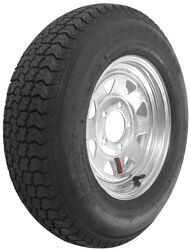
Comparing Radial Trailer Tires and Bias Ply Trailer Tires
Question:
have to replace 2 tires and wheels, makes it simpler for my coleman pop-up, williamsburg, gvw about 3500. loadstar looks best. whats difference between bias / radial radial are 175 that matters to me? we have high-speed road travel, back-country natl park camping, etc. look forward to your thoughts.
asked by: Michael H
Expert Reply:
We actually have an FAQ article on trailer tires, part of which covers bias ply tires versus radial tires. I have posted the section below and I have also included a link to the whole FAQ article for you.
The main difference between a radial ply and bias ply tire is how the tire is constructed. The cords underneath the tire are run in different directions. On a bias tire, the cords run at a 32 degree angle from the direction of travel and on a radial tire, the cords will run at 90 degrees from direction of travel, or across the tire from wheel lip to wheel lip.
Because of the construction of a radial tire, the tire has more flex and will allow for more ground contact. That will improve traction and better tread wear. It also gives the radial tire better stability.
The radial tire will normally run cooler, if not overloaded, which will help the tire last longer, especially when the tire is under a load.
A bias tire has a stiffer sidewall and might be used more on off road applications, like farm use.
At one time the cost was a big difference from the bias to a radial, but now with both tires being close in price the radials are a much better value.
The 175 on the 13 inch radial tires indicates that it is 6.895 inches wide. This is 0.305 inches more narrow than the bias tire you have referenced. The smaller radial tire also has a lower capacity at 1,610 pounds at 65 psi. The bias ply tire is rated for 1,725 pounds at 65 psi. Two of the bias ply tires would provide 3,450 pounds capacity.

Product Page this Question was Asked From
Loadstar ST185/80D13 Bias Trailer Tire with 13" Galvanized Wheel - 5 on 4-1/2 - Load Range D
- Trailer Tires and Wheels
- Tire with Wheel
- Bias Ply Tire
- Load Range D
- 185/80-13
- 13 Inch
- 5 on 4-1/2 Inch
- Steel Wheels - Galvanized
- Boat Trailer Wheels
- Kenda
more information >
Featured Help Information
Miscellaneous Media

Continue Researching
- Shop: Trailer Wiring
- Shop: CE Smith Spare Tire Mount - Locking - Steel - 4-Lug and 5-Lug Wheels - 8-3/4"
- Shop: CE Smith Padlock Brackets for Spare Tire Carriers - Zinc-Plated Steel - 1 Pair
- Shop: Trailer Hitch
- Shop: CE Smith Spare Tire Mount for Trailers - Steel - 4- and 5-Lug Wheels - 8-3/8" Long
- Shop: Kenda 4.80-12 Bias Trailer Tire with 12" White Wheel - 4 on 4 - Load Range C
- Shop: Kenda 4.80-12 Bias Trailer Tire with 12" White Wheel - 5 on 4-1/2 - Load Range B
- Shop: CE Smith Spare Tire Mount for Trailers - Steel - 4- and 5-Lug Wheels - 12-1/4" Long
- Shop: Trailer Spare Tire Mount by Dutton-Lainson
- Search Results: spare mount for trailers
- Search Results: 4.80~12 trailer tire
- Search Results: spare tire lock
- Video: CE Smith Spare Tire Carrier Padlock Brackets Review
- Search Results: 84656uc3~ez
- Search Results: 23~468~469
- Q&A: Difference Between ST205/75D15 and ST205/75R15 Size Tires
- Q&A: Correct Replacement Wheel Bearings and Hub Assemblies For 2017 Trailer West 2 Horse Adventure Mx
- Q&A: Dexter 3,500 lb Nev-R-Adjust Electric Brake Assembly and Compatible Hub Drums
- Shop: RV Interior Lighting
- Search Results: akebrk~35~sa
- Search Results: timbren 3500
- Video: Dexter Axle Trailer Brakes - Electric Drum Brakes - 23-468-469 Review
- Video: Dexter Nev-R-Adjust Electric Trailer Brake Kit Installation
- Q&A: Comparing Bias Trailer Tires with Radial Trailer Tires for an Enclosed Snowmobile Trailer
- Video: Review of Kenda Trailer Tires and Wheels - Tire With Wheel - KE87JR
- Article: Trailer Tire Sizing
- Q&A: What is the Difference Between Load Range C and D ST175/80D13 Trailer Tires
- Q&A: Comparing Tire Sizes ST185/80D13 and ST175/80R13 and Bias Ply/Radial Tire Construction
- Article: Measuring a Trailer Tire
- Q&A: Comparing 175/80-13 And 185/80-13 Tires





